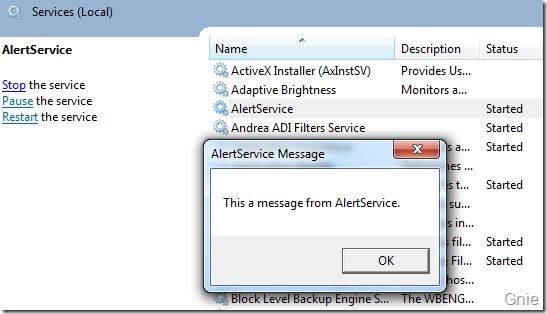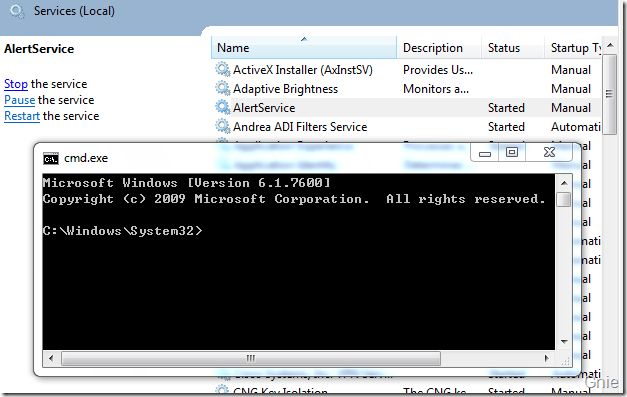穿透Session 0 隔离(二)(How to use Windows service run a GUI application.)
转载自:http://www.cnblogs.com/gnielee/archive/2010/04/08/1707169.html
上一篇我们已经对Session 0 隔离有了进一步认识,如果在开发过程中确实需要服务与桌面用户进行交互,可以通过远程桌面服务的API 绕过Session 0 的隔离完成交互操作。
对于简单的交互,服务可以通过WTSSendMessage 函数,在用户Session 上显示消息窗口。对于一些复杂的UI 交互,必须调用CreateProcessAsUser 或其他方法(WCF、.NET远程处理等)进行跨Session 通信,在桌面用户上创建一个应用程序界面。
WTSSendMessage 函数
如果服务只是简单的向桌面用户Session 发送消息窗口,则可以使用WTSSendMessage 函数实现。首先,在上一篇下载的代码中加入一个Interop.cs 类,并在类中加入如下代码:
public static IntPtr WTS_CURRENT_SERVER_HANDLE = IntPtr.Zero; public static void ShowMessageBox(string message, string title) { int resp = 0; WTSSendMessage( WTS_CURRENT_SERVER_HANDLE, WTSGetActiveConsoleSessionId(), title, title.Length, message, message.Length, 0, 0, out resp, false); } [DllImport("kernel32.dll", SetLastError = true)] public static extern int WTSGetActiveConsoleSessionId(); [DllImport("wtsapi32.dll", SetLastError = true)] public static extern bool WTSSendMessage( IntPtr hServer, int SessionId, String pTitle, int TitleLength, String pMessage, int MessageLength, int Style, int Timeout, out int pResponse, bool bWait);
在ShowMessageBox 函数中调用了WTSSendMessage 来发送信息窗口,这样我们就可以在Service 的OnStart 函数中使用,打开Service1.cs 加入下面代码:
protected override void OnStart(string[] args)
{
Interop.ShowMessageBox("This a message from AlertService.",
"AlertService Message");
}
编译程序后在服务管理器中重新启动AlertService 服务,从下图中可以看到消息窗口是在当前用户桌面显示的,而不是Session 0 中。

CreateProcessAsUser 函数
如果想通过服务向桌面用户Session 创建一个复杂UI 程序界面,则需要使用CreateProcessAsUser 函数为用户创建一个新进程用来运行相应的程序。打开Interop 类继续添加下面代码:
public static void CreateProcess(string app, string path)
{
bool result;
IntPtr hToken = WindowsIdentity.GetCurrent().Token;
IntPtr hDupedToken = IntPtr.Zero;
PROCESS_INFORMATION pi = new PROCESS_INFORMATION();
SECURITY_ATTRIBUTES sa = new SECURITY_ATTRIBUTES();
sa.Length = Marshal.SizeOf(sa);
STARTUPINFO si = new STARTUPINFO();
si.cb = Marshal.SizeOf(si);
int dwSessionID = WTSGetActiveConsoleSessionId();
result = WTSQueryUserToken(dwSessionID, out hToken);
if (!result)
{
ShowMessageBox("WTSQueryUserToken failed", "AlertService Message");
}
result = DuplicateTokenEx(
hToken,
GENERIC_ALL_ACCESS,
ref sa,
(int)SECURITY_IMPERSONATION_LEVEL.SecurityIdentification,
(int)TOKEN_TYPE.TokenPrimary,
ref hDupedToken
);
if (!result)
{
ShowMessageBox("DuplicateTokenEx failed" ,"AlertService Message");
}
IntPtr lpEnvironment = IntPtr.Zero;
result = CreateEnvironmentBlock(out lpEnvironment, hDupedToken, false);
if (!result)
{
ShowMessageBox("CreateEnvironmentBlock failed", "AlertService Message");
}
result = CreateProcessAsUser(
hDupedToken,
app,
String.Empty,
ref sa, ref sa,
false, 0, IntPtr.Zero,
path, ref si, ref pi);
if (!result)
{
int error = Marshal.GetLastWin32Error();
string message = String.Format("CreateProcessAsUser Error: {0}", error);
ShowMessageBox(message, "AlertService Message");
}
if (pi.hProcess != IntPtr.Zero)
CloseHandle(pi.hProcess);
if (pi.hThread != IntPtr.Zero)
CloseHandle(pi.hThread);
if (hDupedToken != IntPtr.Zero)
CloseHandle(hDupedToken);
}
[StructLayout(LayoutKind.Sequential)]
public struct STARTUPINFO
{
public Int32 cb;
public string lpReserved;
public string lpDesktop;
public string lpTitle;
public Int32 dwX;
public Int32 dwY;
public Int32 dwXSize;
public Int32 dwXCountChars;
public Int32 dwYCountChars;
public Int32 dwFillAttribute;
public Int32 dwFlags;
public Int16 wShowWindow;
public Int16 cbReserved2;
public IntPtr lpReserved2;
public IntPtr hStdInput;
public IntPtr hStdOutput;
public IntPtr hStdError;
}
[StructLayout(LayoutKind.Sequential)]
public struct PROCESS_INFORMATION
{
public IntPtr hProcess;
public IntPtr hThread;
public Int32 dwProcessID;
public Int32 dwThreadID;
}
[StructLayout(LayoutKind.Sequential)]
public struct SECURITY_ATTRIBUTES
{
public Int32 Length;
public IntPtr lpSecurityDescriptor;
public bool bInheritHandle;
}
public enum SECURITY_IMPERSONATION_LEVEL
{
SecurityAnonymous,
SecurityIdentification,
SecurityImpersonation,
SecurityDelegation
}
public enum TOKEN_TYPE
{
TokenPrimary = 1,
TokenImpersonation
}
public const int GENERIC_ALL_ACCESS = 0x10000000;
[DllImport("kernel32.dll", SetLastError = true,
CharSet = CharSet.Auto, CallingConvention = CallingConvention.StdCall)]
public static extern bool CloseHandle(IntPtr handle);
[DllImport("advapi32.dll", SetLastError = true,
CharSet = CharSet.Ansi, CallingConvention = CallingConvention.StdCall)]
public static extern bool CreateProcessAsUser(
IntPtr hToken,
string lpApplicationName,
string lpCommandLine,
ref SECURITY_ATTRIBUTES lpProcessAttributes,
ref SECURITY_ATTRIBUTES lpThreadAttributes,
bool bInheritHandle,
Int32 dwCreationFlags,
IntPtr lpEnvrionment,
string lpCurrentDirectory,
ref STARTUPINFO lpStartupInfo,
ref PROCESS_INFORMATION lpProcessInformation);
[DllImport("advapi32.dll", SetLastError = true)]
public static extern bool DuplicateTokenEx(
IntPtr hExistingToken,
Int32 dwDesiredAccess,
ref SECURITY_ATTRIBUTES lpThreadAttributes,
Int32 ImpersonationLevel,
Int32 dwTokenType,
ref IntPtr phNewToken);
[DllImport("wtsapi32.dll", SetLastError=true)]
public static extern bool WTSQueryUserToken(
Int32 sessionId,
out IntPtr Token);
[DllImport("userenv.dll", SetLastError = true)]
static extern bool CreateEnvironmentBlock(
out IntPtr lpEnvironment,
IntPtr hToken,
bool bInherit);
在CreateProcess 函数中同时也涉及到DuplicateTokenEx、WTSQueryUserToken、CreateEnvironmentBlock 函数的使用,有兴趣的朋友可通过MSDN 进行学习。完成CreateProcess 函数创建后,就可以真正的通过它来调用应用程序了,回到Service1.cs 修改一下OnStart 我们来打开一个CMD 窗口。如下代码:
protected override void OnStart(string[] args)
{
Interop.CreateProcess("cmd.exe",@"C:\Windows\System32\");
}
重新编译程序,启动AlertService 服务便可看到下图界面。至此,我们已经可以通过一些简单的方法对Session 0 隔离问题进行解决。大家也可以通过WCF 等技术完成一些更复杂的跨Session 通信方式,实现在Windows 7 及Vista 系统中服务与桌面用户的交互操作。

参考资料
1. WTSSendMessage Function
http://msdn.microsoft.com/en-us/library/aa383842(VS.85).aspx
2. CreateProcessAsUser Function
http://msdn.microsoft.com/en-us/library/ms682429(v=VS.85).aspx
3. WTSSendMessage (wtsapi32)
http://www.pinvoke.net/default.aspx/wtsapi32/WTSSendMessage.html
4. WTSQueryUserToken Function
http://msdn.microsoft.com/en-us/library/aa383840(VS.85).aspx
代码下载